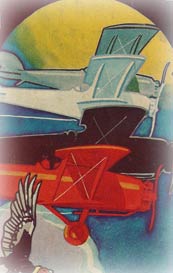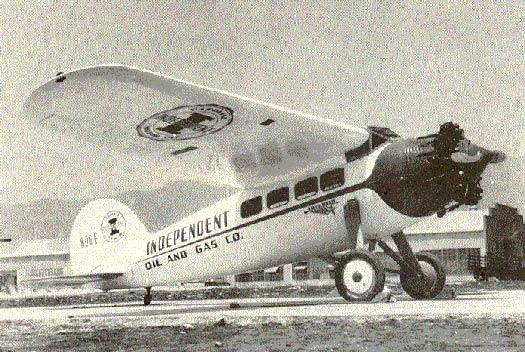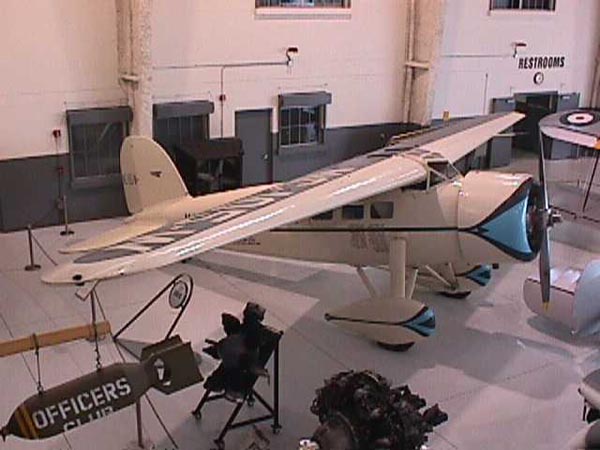|
Registration Number NC898E
A Museum Specimen in Disguise
PLEASE READ ON FOR DIRECTIONS TO A VIDEO OF THIS AIRPLANE
NC898E is c/n 72 built by Lockheed Aircraft Corp., Burbank,
CA. It is the first "Executive"
model 5A, fitted with a folding desk, brand new typewriter,
curtained windows and chemical toilet. You may see references
to it on pp. 159 and 215 in the Allen reference cited in the left sidebar.
Image, below, from p. 159.
It was manufactured June 15, 1929.
NC898E left the factory with a Pratt & Whitney Wasp B engine
(S/N 1616) of 450HP. It was a five-place airplane, weighing
4,217 pounds gross.
It sold on July 1, 1929 to Erle P. Halliburton, Tulsa,
OK.
Halliburton was a Lockheed distributor. It sold on July 6,
1929 to Independent Oil & Gas
Company of Tulsa, and was used by the firm's vice president,
Gillette Hill, for business trips and sales promotion. It
was painted white with blue trim. The image shows it in company
livery.
NC898E landed at Tucson six times between July 1, 1929
and September 17, 1931. This ties it with NC7952,
which also landed six times. There were 147 total landings
by Lockheed aircraft at the Davis-Monthan Airfield, but NC7952 and NC898E landed the most. Landing at Tucson, NC898E was
flown by three different pilots.
The first three landings, on July 1 (solo), August 2nd (four
passengers) and August 16, 1929 (two passengers) were flown
by Tom D. Park. This during the time when the airplane was
owned by Independent Oil & Gas. NC898E was the official plane
for the KansasCity-Mexico City Air Derby of 1929. The airplane
was featured on the trademark of Independent's "Tailwind"
gasoline.
NC898E was flown in the Mexico City to Kansas City derby in September, 1929. The derby was a major event at both ends of the route. The Lewiston (ME) Evening Journal of September 21st described air show activities, including a nine-day "international air circus," at Kansas City even as the derby planes made their way to Mexico City for the beginning of the 1,500-mile race. And the Spokane (WA) Spokesman-Review of September 22, 1929 reported that, besides Dole Race winner Art Goebel, Dale Jackson, Pancho Barnes, Sydnor Hall, Rex Purcell, Luis R. Veredeja, "... and other Mexican and Cuban aviators are expected to participate."
NC898E was used as the lead route finding airplane for the derby as indicated in the article below. Register pilot Tom Park's (at left, below) final visit with 898E was on August 16, 1929, just a few weeks before the derby.
News Reportage of KC to MC Derby, Ca. September, 1929, Source Unknown (Source: Woodling)
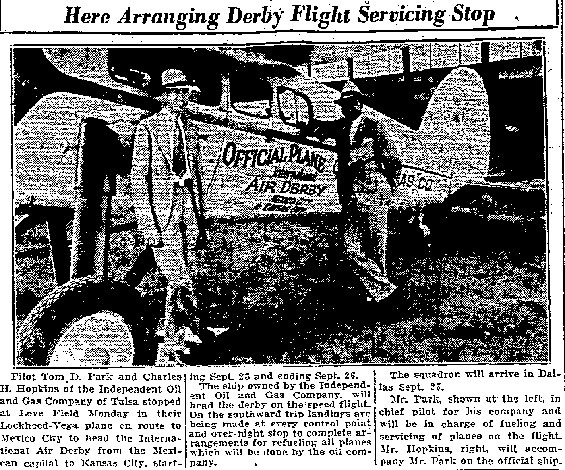 |
The winner of the derby was Art Goebel who is shown second from right in the photograph below from the Missouri Valley Special Collections, Kansas City Public Library, Kansas City, MO (KCPL). The airplane is NC898E. The writing painted on the fuselage, visible in the article above, is hidden by the men, below. Does anyone KNOW who the other men are?
Lockheed Vega NC868E (Source: KCPL)
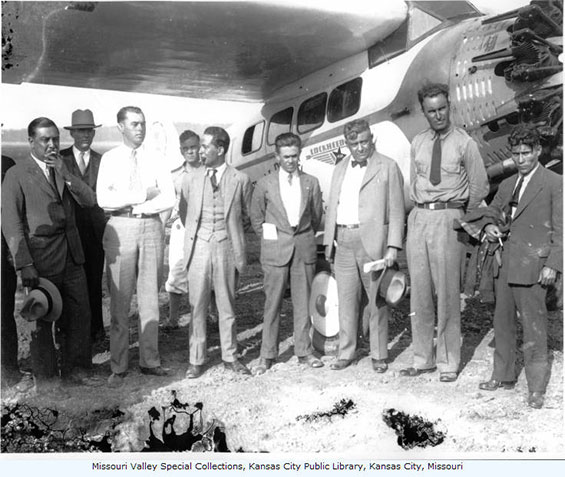 |
In 1931, Independent Oil was acquired by Phillips Petroleim
Company, Bartlesville, OK. The next two landings at Tucson
were made on July 18th and August 18, 1931. Both were flown
by Will
D. "Billy" Parker. Parker was the aviation manager
for Phillips. Parker brought the airplane to Clover Field, Santa Monica, CA on August 19, 1931, a day after his last landing at Tucson.
Phillips sold the airplane to Parks Air College, St. Louis,
MO on August 28, 1931. The final landing at Tucson was made
by M.V. Foley on September 17, 1931. Based in St. Louis,
Foley carried three unidentified passengers. They were westbound
from St. Louis to Los Angeles, CA. Foley also appears in the Parks Airport Register with the airplane on December 22, 1931.
It sold six more times through February 21, 1942, serving
variously as private transport and photo ship with Iowa Aerial
Surveys, and receiving a conversion to a Vega 5C under ATC
384. It sold July 24, 1942 to Charles
H. Babb. Babb sold it into Mexico where it served
as a transport airplane until 1955 under Mexican registration
numbers XA-DOK and XB-MAA.
Image, above, shows our airplane in Mexican registry. Exact
date is unknown, but it's probably between its sale into
Mexico on July 24, 1942 and sometime in 1955. Image from
your Webmaster's collection.
At some point (the NASM record is tortuous and truncated) the
airplane returned to the U.S. It wound up with the
General Electric Company, Schenectady, NY. They overhauled
it and used it as a restricted aircraft for antiradar testing.
As of the upload date of this page, NC898E
is owned by Kermit Weeks, and is on display
at his Fantasy
of Flight museum, Polk City, FL. It is currently painted, registered
and numbered as Wiley
Post's "Winnie Mae". Below is a photo emailed
to me in 2000 by Mr. Weeks of NC898E at his museum.
NC898E was flyable through 1988, but it is not flown now. It is, however, being restored in central Florida. Come back to this page from time to time to be updated on the restoration and first flights.
---o0o---
On April 9, 2008 I had the pleasure of visiting the Fantasy of Flight museum and acquiring permission to photograph and video our Vega. At this LINK you will find a movie of the outside and INSIDE of the airplane (follow the link and choose VegaMovieAvi). Friendly Warning: this is a 23-minute, leisurely tour of the airplane. The outside walk-around takes about seven minutes; the remaining 16 minutes are spent inside looking around and imagining what it was like to fly around in a Lockheed Vega during the 1930s. I left my video and commentary uncut for your enjoyment, along with the spider webs, cramped quarters inside the airplane, and normal noises of this busy museum. Please take the tour. There aren't many of these airplanes in existence, and the video is probably the only such tour of the inside of a Lockheed Vega you'll find on the Web.
---o0o---
Now that you've viewed the video, please consider the following. As preface to this exhibit of still photos of NC898E, I present the following two images of the original interior view of a Lockheed Vega Executive model as pictured on page 160 of Allen. The top image is the view forward, with the triangular cockpit door closed, but showing small round windows into the pilot's space. Compare these to the configuration of the airplane today that you saw in the video.
Interior, Fore & Aft, of Lockheed Vega Executive Model
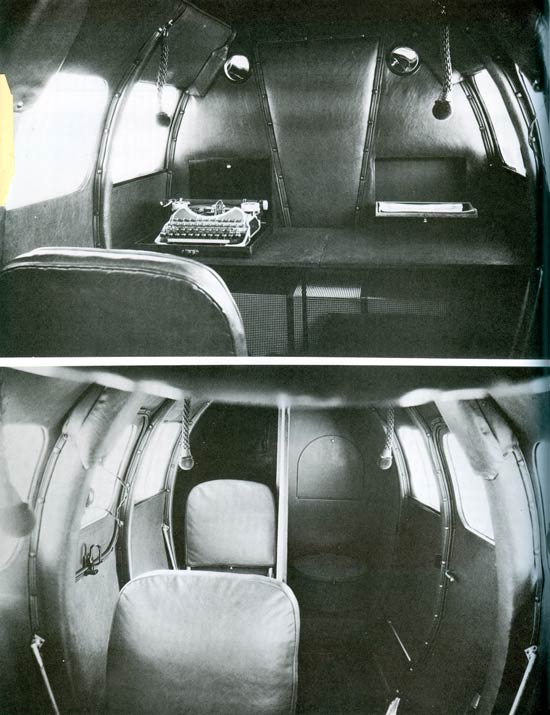 |
This interior appears to lack the window curtains that were part of the Executive model furnishings. The typewriter and desk, as well as the chemical toilet aft, are visible. I believe the lavatory folds down from the "D"-shaped panel at right. Note the courtesy hand holds. The window emergency exit and door hardware differ slightly from the movie.
Following are five images courtesy of Lockheed-Martin via the Tim Kalina collection (cited, right sidebar). He says of the images, ...these photos were of an oil company Vega so they may well be NC898E. And if NC898E had the very first executive interior fitted to a Vega it would make sense that Lockheed took all these interior photos. I really haven’t seen that done with the interior of any other Vega."
Regardless of whether these are of NC898E, immediately below is an image of the Executive passenger compartment with the view forward. Notice the one difference between this image and the top one of the pair above: the cockpit door is open, and we note the door is hinged at the top. Compare this with the image of NC898E that I labeled "NC898E Cockpit Entrance From the Rear" below, where the door is hinged on the right. Mr. Kalina says of the door geometry, "I think the cockpit door (in the cabin) was triangular and narrow at it’s bottom so as to fit in the narrow cabin aisle. This would also explain why it was designed with the hinge on the top. If this door opened to the side it would hit the legs of any passenger sitting just behind the cockpit bulkhead." It is unclear if NC898E left the factory that way, or the hinge modification was performed at a later date.
Executive Interior, Forward
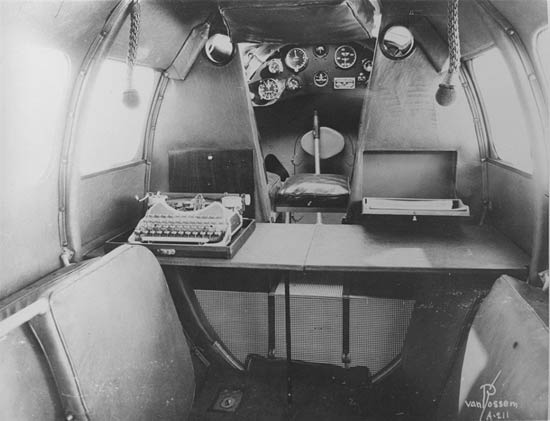 |
Notice, too, in this image the position of the pilot's seat and the use of the door as the seat-back. One can only wonder what might happen if the door latch failed during climb. There are clear differences in the instrument panel, compared with the motion video and the images below. The airplane dataplate is visible attached to the instrument panel, rather than overhead in the passenger cabin as in the video and in the image below.
The image below appears to be of the same interior as the lower panel in the double image above. Notice the side seating has been stowed and the right rear seat has been deployed. There appears to be a screen put in place in front of the commode and lavatory. These images demonstrate the flexible configurations for this airplane.
Executive Interior, to the Rear
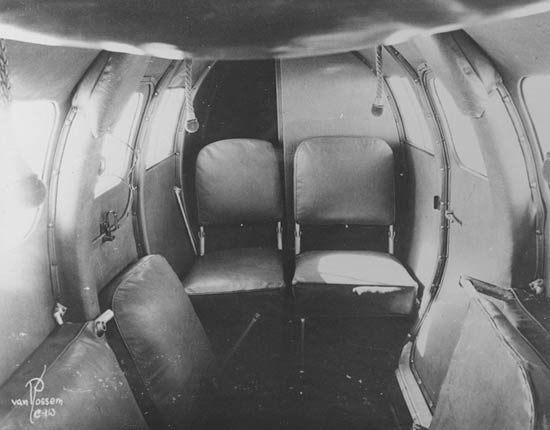 |
Below, a long view forward in yet another Vega interior. This airplane is unidentified, but it is not an Executive model. All the seats are stowed. We see the design reason for hinging the cockpit door at the top: it allows it to swing open fully when seats are either stowed or deployed. Note the simplicity of the instrument panel. This photograph looks like it was taken from behind the rear set of seats (seat backs in foreground). The passenger courtesy handles are different from the Executive model. Notice, too, the design of the overhead light fixture and courtesy handle attach hardware and compare them with those visible in the video and in the other images below.
Vega Interior, Long View Forward
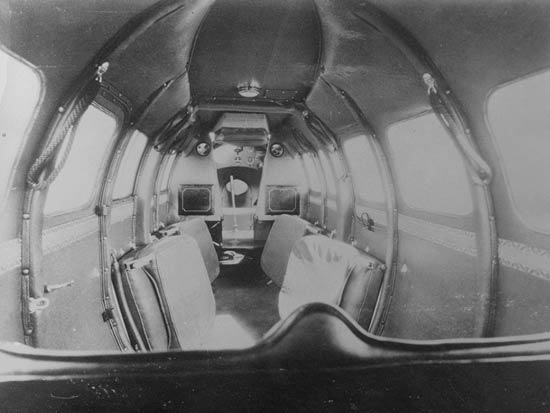 |
Below, a long view rearward in what looks to be the same Vega as above. The seating is deployed in this view, showing how the seatbacks recline and a headrest is fitted for snoozing on long flights. You can see the flute separating the two rear seats, which is also visible in the foreground of the image above. The seat coverings were probably leather. Seatbelts are not fitted. Tim Kalina states about the seat coverings, "Actually, as early as 1910 duPont was producing a fabric called ‘Fabrikoid’ which was meant to resemble leather. My research has shown that Lockheed used Fabrikoid as their standard cockpit upholstery and I believe it was also offered for cabin use. Of course, an executive plane like NC898E would have used real leather and I am sure many of the Vega and Orion cabins were fitted out in leather." Naugahyde, a vinyl coated fabric, was still 25-30 years away. For the history of Fabrikoid, see this reference. At least three of the 20th century duPont family were Golden Age pilots who signed our Register.
Vega Interior, Long View Rearward
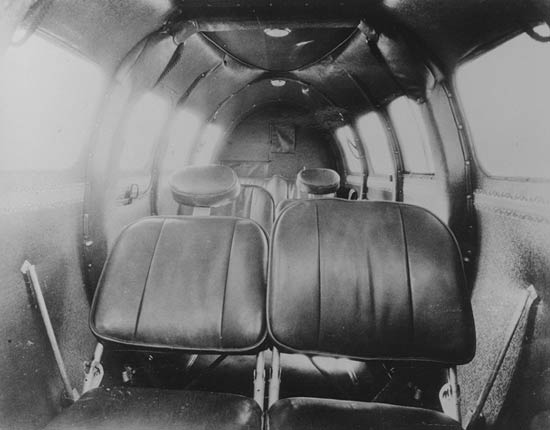 |
---o0o---
Below, the throttle quadrant and lower left-hand instrument panel of NC12288 (not a Register airplane). This photo was taken in 1981 by John Oder and is exhibited here with his permission. Mr. Kalina says of this image, "The throttle looks original, but I don’t know what is original on the instrument panel [compare the magneto switch with the video and the color photograph below]. Judging from the other photos John took in the cockpit of c/n161 it appears as if much is, indeed, original. This Vega was restored in the early 1980s and flown by a couple different owners. It was ground-looped a couple of times, the last twisting the fuselage badly enough to ground the plane in the very late 1990s. It’s in storage now...." The design of this throttle quadrant is different than the one pictured just below, right.
Throttle Quadrant of Vega NC12288, 1981
 |
---o0o---
Now, below are some of the detail images I took inside NC898E. Compare them with the movie. The blue-green upholstery is not original. The original Lockheed cockpit color was a medium gray.
NC898E Instrument Panel
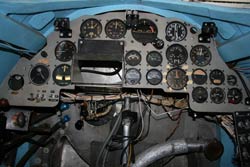 |
NC898E Throttle Quadrant
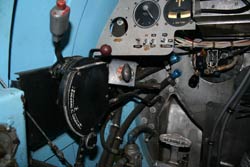 |
NC898E Magneto Switch
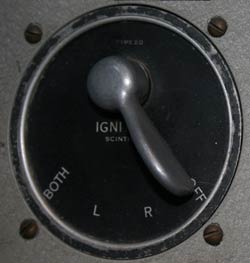 |
NC898E Door Handle
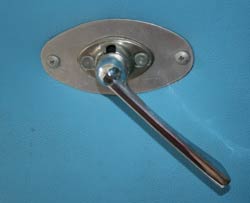 |
The door handle and magneto switch have a chance of being original equipment. But compare this handle with the one in the black & white image above.
Most likely the instruments in the panel have been changed out over the years, especially as it was used as a research craft by General Electric. I looked closely at all the instruments and it is hard to guess which are original.
The data plate shown below, is, however, original, showing that the airplane was manufactured June 15, 1929. It also reflects its conversion to a model 5C in 1942 ("officially" it probably received a new data plate then, but the provenance goes back to the original date of manufacture). The serial number, 72, as usual did not change with the conversion.
NC898E Original Data Plate
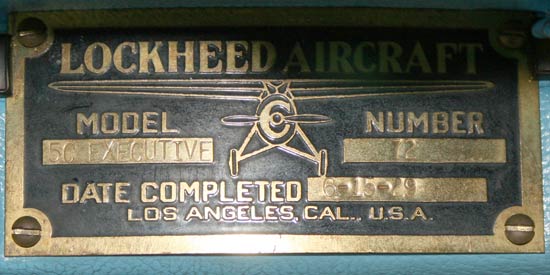 |
NC898E Hand Hold Detail
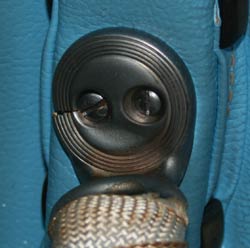 |
NC898E Emergency Window Exit
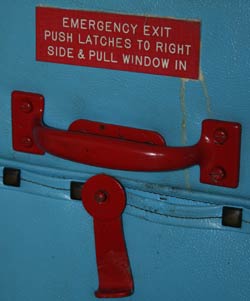 |
At left is the emergency exit mechanism for the starboard passenger compartment window. The placard is new, but the wording is, by law, the same as it was when the airplane was converted under ATC
384. Placard wording is a legal part of the Type Certificate and may not be changed. As with the curtains, however, the placard appears to be missing in the black & white image. Likewise, the window lock mechanism in the black & white image above is at the bottom of the window. Perhaps you noticed in the movie that the metal loop mechanism was at the top of the window.
Above right, the cast metal courtesy hand hold hardware is probably original. The rope that was attached to it was nylon and new. Note the Art Deco detail, and compare the position of the hand holds with the black & white image. Compare also the square upholstery tacks, which are the same type as in the original.
Below, the airworthiness certificate issued in 1969 for NC898E. It was displayed in the airplane, but I do not know if a more recent one exists, or if this one is valid. Note that the airplane is now officially registered as NC105W. This was Wiley Post's old number for the "Winnie Mae". Since the "Winnie Mae" is now retired to the Smithsonian, the number was free for someone else to capture and use.
NC898E Airworthiness Certificate
 |
Below, located at the pilot's left elbow in the cockpit, is the fuel tank control valve (L) and the hand-operated fuel wobble pump. These appear to be original.
NC898E Wobble Pump and Fuel Control
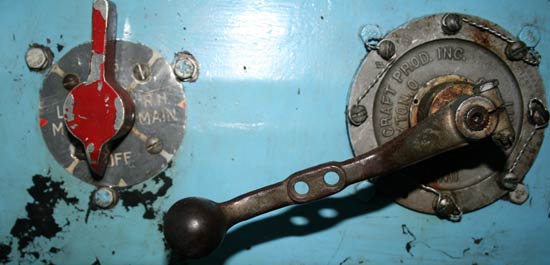 |
NC898E Aileron Control Cable, Starboard
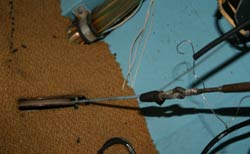 |
NC898E Port Wing Attach Hardware
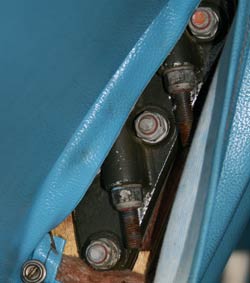 |
The wing attach brackets are fastened to the airframe with bolts and self-locking nuts. At left is the port attachment with the upholstery pulled aside to enable inspection. Considering standard fabrication practices today, the vertical bolts are too long. They should extend past the nut only three threads at most. At right is the starboard aileron control cable as it ascends through the cockpit floor from the control stick (note gold floor carpeting), past the pilot's right shoulder, and out into the right wing. For some reason its safety wire has been partially removed from the shackle. See the image, Front Starboard Quarter, below to view this cable as it penetrates the forward fuselage and enters the right wing.
NC898E Pilot's Eye View From the Cockpit
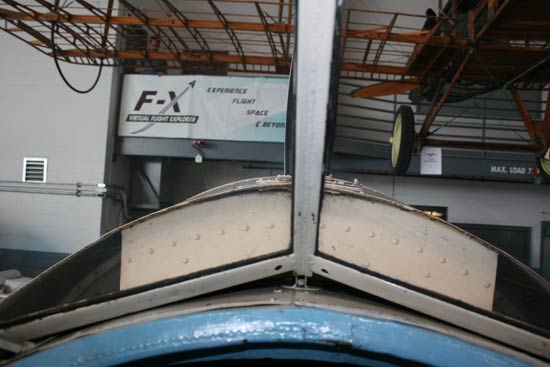 |
Above, what the pilot sees out the windshield while the airplane is on the ground. The propeller is vertical, partially hidden by the windshield center brace. The rear of the engine cowling is visible.
NC898E Tailwheel
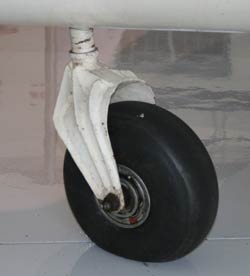 |
NC898E Cockpit Entrance From the Rear
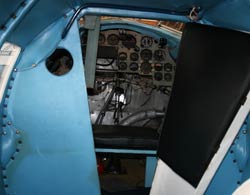 |
The cockpit is entered from the passenger compartment (alternatively there is a top hatch). The door is roughly triangular and requires the pilot to step over the non-adjusting seat bench. Compare with the closed door in the black & white image above. I sat on the bench and found it low (and I'm pretty tall). The bench height probably allows for a parachute to be worn by the pilot. All in all, it's a fairly uncomfortable cockpit with a non-adjusting seat back as well (note the door is padded and serves as the seat back), and rudder pedals are spread far apart.
If we face the rear of the airplane, we note that it no longer has a chemical toilet or lavatory. If we go behind the last passenger seats, and look into the empennage, we see the images below.
NC898E Empennage
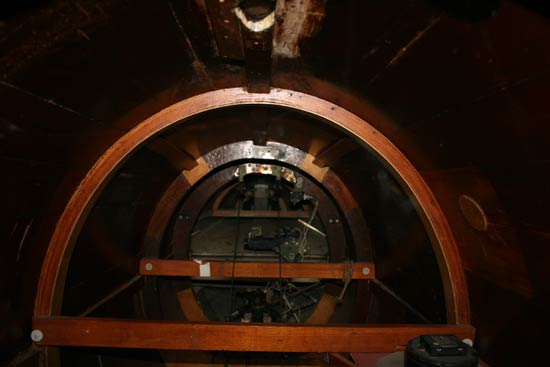 |
This Vega is an all-wood airplane (although later models were made of metal). Its fuselage was fabricated of plywood in two halves, then glued together down the middle. The photo above (as well as below) shows the view all the way to the rear with the horizontal stabilizer visible as a relatively flat platform lower center.
NC898E Empennage, Starboard Angle
 |
Above, the rudder control cables are visible at the right of the image and the detail of wood structure is visible at left. Note the brad heads on the bulkheads and gussets, and the straightness of the wood grain on the cross-brace at the lower third of the image. Wood for airplane structures is carefully selected for straight grain. The top of the tail wheel trunion is visible at lower right.
Outside the airplane the engine is tightly cowled. By comparison of serial numbers, the engine is not the original Pratt & Whitney.
NC898E Engine Cylinder Detail
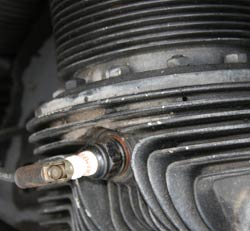 |
NC898E Pratt & Whitney Engine
 |
Although it is a wooden airplane, the exterior of NC898E is covered with fabric. Below, left, is evidence of that as shown by the pinked fabric border visible at center.
NC898E Starboard Main Gear Detail
 |
NC898E Fabric Covering
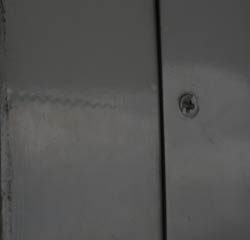 |
Although the gear geometry is original (the view, right, is of the inner side of the right main gear), the wheels and brakes appear to be modern.
NC898E Landing Gear Fuselage Fairing
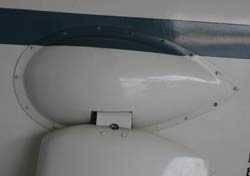 |
NC898E Passenger Door Hinge Detail
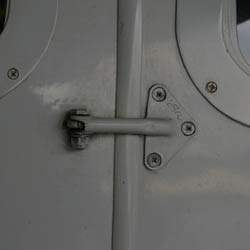 |
Below, port side view of NC898E. The fuselage fairing for the landing gear pictured above right is clearly visible at the top of the gear strut just under the front-most passenger window.
NC898E Port View
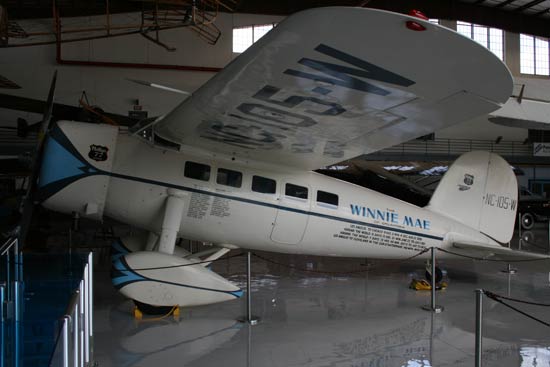 |
Below, two views of the lettering on the port side. These inscriptions, of course, are relevant to NC105W and Wiley Post's around-the-world flights, not to NC898E.
NC898E Port Lettering Detail, Front
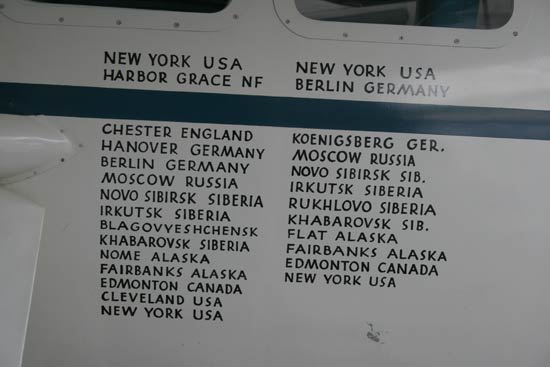 |
NC898E Port Lettering Detail, Rear
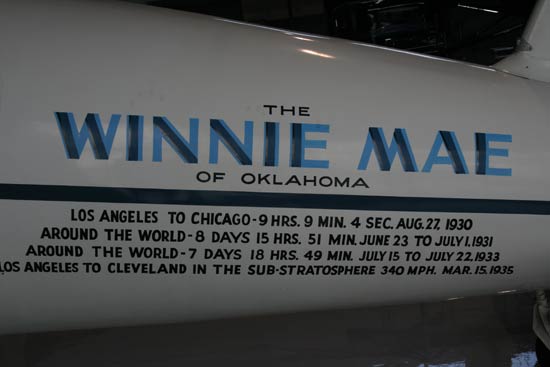 |
Below, a view from the rear port quarter showing the large elevators and rudder as well as the pointed "stinger" that comprises the very rear tip of the empennage.
NC898E Rear Port Quarter
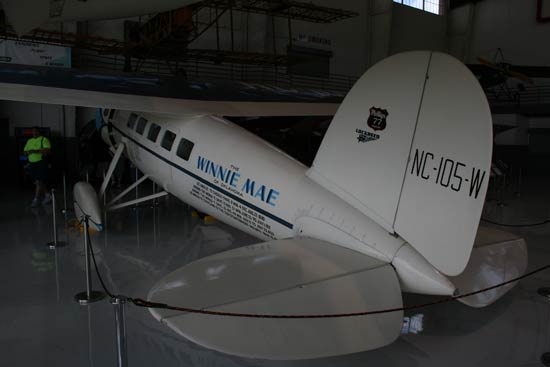 |
Below, NC898E from the front starboard quarter.The cable from the top of the fuselage, across the right window and into the wing root is the continuation of the aileron cable pictured in the image above. Closer detail of this cable is in the movie.
NC898E Front Starboard Quarter
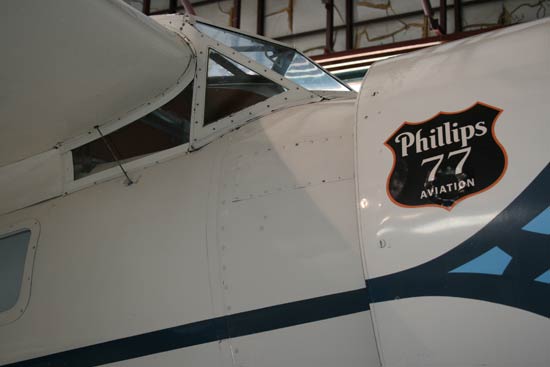 |
Phillips aviation gasoline and oil were popular products during the Golden Age. See Art Goebel and Billy Parker.
NC898E also landed once at Parks Airport flown by Foley, on Tuesday, December 22, 1931. As of August, 2014, NC898E is undergoing restoration to flying condition. A film of the process is at the link.
---o0o---
THIS PAGE UPLOADED: 06/05 REVISED: 04/12/06, 06/22/06, 09/11/06, 04/16/08, 04/22/08, 05/05/08, 01/04/14
|

